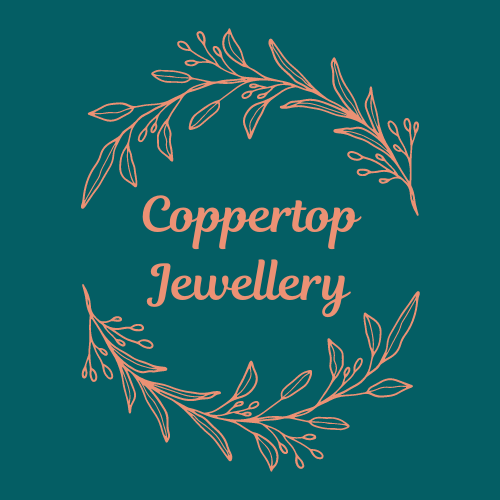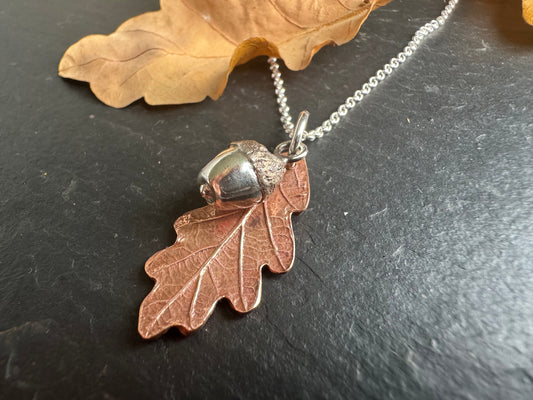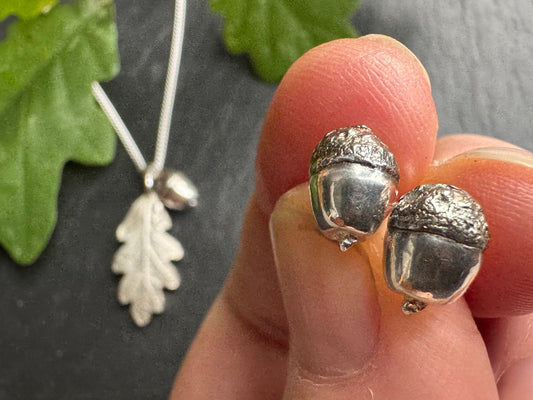Frequently Asked Questions
- Why are you called Coppertop Jewellery?
- What is your jewellery made from?
- What are the benefits of recycled metal?
- What is precious metal clay?
- How do you turn real leaves into silver?
- What’s the different between fine (999) silver and sterling (925) silver?
- How long does it take to make?
- Why does handmade cost more?
- How is Coppertop Jewellery Sustainable?
- Who makes your jewellery?
- Do you do classes?
- Where can I physically see your jewellery?
- Do you do custom work and is it more expensive?
- Why is a doctor making jewellery?
- What inspires your different designs?
- What is tarnish?
- How do I look after my jewellery?
- What if I break, lose or don’t like my jewellery?
- What is your return policy?
- Do you do repairs of any jewellery?
- What are your shipping costs?
1. Why are you called Coppertop Jewellery?
'Coppertop' is an old nickname for someone with red hair!
2. What is your jewellery made from?
Coppertop Jewellery is crafted using different metals depending on the piece and the process. Recycled solid silver and copper are the most commonly used. Precious metal clay in silver (999 fine silver) or copper is used to recreate many of the botanical pieces. I also use recycled sterling silver (925) sheet and wire, especially when stone setting. Gold and brass are occasionally used in my mixed metal pieces.
3. What are the benefits of recycled metal?
Using recycled metal offers significant benefits for both the environment and humanity. Environmentally, it reduces the need for mining, which is a resource-intensive and often polluting process that can lead to habitat destruction, soil erosion, and water contamination. Recycling metal dramatically lowers energy consumption and greenhouse gas emissions compared to extracting new metal from ore. For mankind, it promotes more ethical and sustainable production practices, reduces exposure to the harmful and sometimes exploitative conditions often faced by workers in mining industries, and helps conserve finite natural resources for future generations. By choosing recycled metals, we support a circular economy that values sustainability and social responsibility.
4. What is precious metal clay?
Precious metal clay is a unique and innovative material made from tiny particles of pure metal such as silver, gold, or copper suspended in an organic binder and water to create a malleable, clay-like substance. Originally developed in Japan, it is often made using recycled metals sourced from industrial processes, cars, old electronics, or photographic film. This makes it an eco-friendly option for jewellery making. Once shaped into a design, the clay is dried and then fired in a kiln or with a torch. During firing, the binder burns away, leaving behind a solid piece of pure metal. The result is a finished item that can be polished, textured, or patinated just like traditional metal jewellery. This process allows artisans like myself to create intricate and detailed designs while supporting sustainable and responsible crafting practices.
5. How do you turn real leaves into silver?
Natural materials are one the sources of my inspiration, I love their shapes, textures and patterns. I make a mould of the leaf and then create the piece using precious metal clay in the mould. This then takes the form of the leaf. There is no leaf inside the piece with my process. Once the clay is dried there’s lots of sanding before it is fired. That’s when it turns from silver clay to solid silver. After that there’s, filing and polishing before assembling into a piece of jewellery.
6. What’s the different between fine (999) silver and sterling (925) silver?
The quality of silver varies depending on its purity and composition. Fine silver is 99.9% (or ‘999’ parts per 1000) pure silver, making it softer and more resistant to tarnish, which is ideal for delicate jewellery or pieces made from precious metal clay. Sterling silver, on the other hand, is an alloy containing 92.5% silver and 7.5% other metals, usually copper, which gives it greater strength and durability while retaining the bright shine of silver. This makes sterling silver a popular choice for most jewellery, especially rings and items that need to withstand daily use.
7. How long does it take to make?
This is the ‘piece of string’ question that’s always a struggle to answer. My work is completed in many stages, and these often don’t run consecutively so it’s hard to time accurately. I also make many different designs. However, the simplest of pieces may take less than an hour, but more complex pieces take many hours, and this is reflected in the price.
8. Why does handmade cost more?
Handmade jewellery costs more than factory-made, imported pieces due to a range of factors that reflect the value of skilled craftsmanship and small-scale production. Each piece is made individually, often taking hours of meticulous work due to the many stages in the process (including designing, resourcing, constructing, sanding, polishing, assembling and packaging). This proportionally increases labour costs of each individual piece compared to mass production. The materials used are ethically sourced and of high quality. Additionally, there are lots of other costs to cover such as gas & electricity, tools and consumables, insurance, public liability and professional indemnity cover, website/IT fees, hallmarking, packaging, accountancy as well as fees for selling at events or markets (I’m sure there’s more!). Unlike factories that benefit from economies of scale (but also have more wastage), handmade jewellery involves higher per-piece costs. You are investing in an original, inspired, unique piece of wearable art that has been created with passion and supports a local artisan with sustainable practices, like me.
9. How is Coppertop Jewellery Sustainable?
I endeavour to run Coppertop Jewellery as sustainably as I can. I demonstrate this by using recycled metals, which minimises the need for new mining and reduce waste. Where I can, choosing responsibly sourced gemstones that are fair trade, conflict-free, or lab-grown, this helps protect human rights and ecosystems. My jewellery comes presented in eco-friendly cardboard boxes made from sustainable FSC sources. Producing jewellery in small batches or made-to-order further avoids overproduction, reduces wastage and unnecessary consumption. I support UK suppliers, reducing transportation emissions and supporting the UK economy. Finally, offering quality, timeless designs that are meant to last encourages mindful buying over fast fashion
10. Who makes your jewellery?
I do! My name is Caroline Powell and I’m the owner and creator of Coppertop Jewellery.
11. Do you do classes?
Not currently, however, I am asked this frequently and am considering the feasibility of this as I would love to offer these. There’s a lot to consider with suitable premises and health and safety before even considering what to make! If this is something you would be interested to learn more about then please sign up to the Coppertop Club email and be the first to know!
12. Where can I physically see your jewellery?
The internet is convenient, but it’s also lovely to see and feel my jewellery. A range of Coppertop Jewellery is currently stocked in;
Ø Bird’s Yard, 44 Chapel Walk, Sheffield, S1 2PD
Ø Wickwire, 1B Nether Edge Road, Sheffield, S7 1RU
Ø Michael Claxton Gallery & Studio, 26 Abbey Lane, Sheffield, S8 0BL
Ø MS Gallery, 5 South Street, Chesterfield, S40 1QX
I also attend regular events/artisan fairs and at these I offer the widest range of my work, including ‘one of a kind’ pieces. It’s also an opportunity to meet me and say hello! If you want to be informed about future events I’ll be attending, please sign up to the Coppertop Club email list.
13. Do you do custom work and is it more expensive?
I am happy to discuss custom pieces if you contact me by email – coppertopjewellery@gmail.com or by message on Instagram or Facebook. I will happily discuss your idea, advise whether it’s something I can take on and give you quote to consider. Custom pieces can be more expensive when additional time designing and resourcing are required. If you wish to proceed custom pieces usually require a deposit or upfront payment.
14. Why is a doctor making jewellery?
I qualified as a doctor in 1998 and spent 25 years working in the NHS. Unfortunately due to health reasons I sadly had to leave my career. Making jewellery and being creative was a hobby and I soon realised how much I loved it and the creative and mindful process were doing me a lot of good! Through a mixture of being self taught and doing a silversmithing diploma I have developed my skills and love the challenge of learning more. I realised how passionate I felt about what I was doing, and this fuelled my decision to build Coppertop Jewellery.
15. What inspires your different designs?
Although I live in a city, it’s a very green city. I’m close to many woodlands and a short trip into the Peak District. Walking in these natural environments gives inspiration from the flora and the landscape. I’m particularly drawn to pattern that we see in nature and often use this in my jewellery.
16. What is tarnish?
Tarnish on jewellery is caused by a chemical reaction between the metal and substances in the environment, most commonly sulphur and oxygen. For silver jewellery, tarnish occurs when silver reacts with sulphur-containing compounds in the air, forming a dark layer of silver sulphide on the surface. Humidity, air pollution, sweat, cosmetics, and even certain foods (like eggs and onions) can accelerate this process. Other metals, such as copper or brass, also tarnish due to oxidation. While tarnish doesn’t damage the metal itself, it dulls the appearance of jewellery and requires regular cleaning or protective storage to maintain its shine.
17. How do I look after my jewellery?
To keep your silver and copper jewellery looking its best, follow these care tips:
o Store properly: Keep jewellery in a dry, airtight container or a tarnish-resistant pouch to slow down oxidation. Separate pieces to avoid scratching.
o Avoid moisture: Remove jewellery before showering, swimming, or exercising to prevent tarnish and corrosion caused by water and sweat.
o Keep away from chemicals: Avoid contact with perfumes, lotions, cleaning products, and household chemicals, which can damage the metal.
o Clean regularly: Use a soft cloth or a jewellery polishing cloth to gently wipe off oils and tarnish after wearing. For deeper cleans, use a mild soap and warm water with a soft toothbrush, drying thoroughly afterwards.
o Use natural cleaning methods: For copper, a mixture of lemon juice and baking soda can restore shine; for silver, a baking soda and foil soak can lift tarnish without harsh abrasives.
o Wear often: Surprisingly, wearing your jewellery frequently can help reduce tarnish, as the natural oils from your skin can protect the metal.
Consistent care helps preserve the beauty and longevity of your handmade pieces.
18. What if I break, lose or don’t like my jewellery?
It’s my desire to make sure you are happy with your jewellery. If unfortunately a piece of Coppertop Jewellery should break please get in touch via email and I will organise to mend or replace the item.
If you have lost an item then please get in touch as I am often able to make a replacement for you.
If you have changed your mind about your purchase then returns are accepted within 30 days from date of receipt. Jewellery must be returned new and unused in the original box, and the customer is responsible for shipping costs.
Earrings for pierced ears are non-returnable unless faulty.
19. What is your return policy?
If you have changed your mind about your purchase then returns are accepted within 30 days from date of receipt. Jewellery must be returned new and unused in the original box, and the customer is responsible for shipping costs.
Earrings for pierced ears are non-returnable unless faulty.
20. Do you do repairs of any jewellery?
I am happy to repair any Coppertop Jewellery pieces, but otherwise I don’t offer general jewellery repair services.
21. What are your shipping costs?
Standard UK tracked delivery is £3.99 or free on purchases over £50.
Unfortunately, I am unable to ship to Europe.
Other international shipping charges start from £16 and will be calculated at checkout for your country. Please email for further information.
Featured collection
Click 'Shop Jewellery' above to search further on each jewellery type.
-
Copper baby oak leaf and silver acorn pendant
Regular price £79.00 GBPRegular priceUnit price / per -
Handmade Acorn and Baby Oak Pendant Necklace
Regular price £95.00 GBPRegular priceUnit price / per -
Handmade Silver Acorn Stud Earrings
Regular price £60.00 GBPRegular priceUnit price / per -
Beech Silver Stud Earrings
Regular price £42.00 GBPRegular priceUnit price / per







